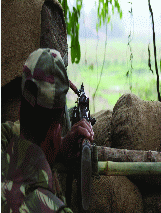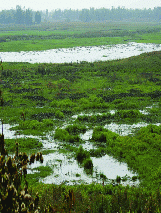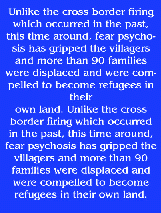Border Firing Muktapur
Border Firing: Muktapur
 Months have elapsed since the Border Security Force and the Bangladeshi Rifles first exchanged fire on the Indo-Bangla border on the Dawki - Muktaur Sector. Since then, the exchange of fire has reoccurred almost on a regular basis which has affected the border villages like Amlympiang, Muktapur, Narjuli, Rongtilla and other adjacent ones. This is not the first incident where the two neighbouring countries exchanged fire in spite of having a seemingly friendly relationship, but this is the first time that the firing has continued for more than a month.
After the initial February 4th firing, another round of fire was exchanged on February 14th & 28th and the last reported exchange of rounds was on March 14th. The other significant feature of this prolonged conflict is also the incidents where the villagers on both sides of the border where involved in scuffles on
Months have elapsed since the Border Security Force and the Bangladeshi Rifles first exchanged fire on the Indo-Bangla border on the Dawki - Muktaur Sector. Since then, the exchange of fire has reoccurred almost on a regular basis which has affected the border villages like Amlympiang, Muktapur, Narjuli, Rongtilla and other adjacent ones. This is not the first incident where the two neighbouring countries exchanged fire in spite of having a seemingly friendly relationship, but this is the first time that the firing has continued for more than a month.
After the initial February 4th firing, another round of fire was exchanged on February 14th & 28th and the last reported exchange of rounds was on March 14th. The other significant feature of this prolonged conflict is also the incidents where the villagers on both sides of the border where involved in scuffles on at least two occasions as reported.
at least two occasions as reported.
Unlike the cross border firing which occurred in the past, this time around, fear psychosis has gripped the villagers and more than 90 families were displaced and were compelled to become refugees in their own land. The few existing schools were closed and at one point of time a school building had to be used as a makeshift shelter for the displaced villagers.
The pertinent question here is why is this border conflict occurring every now and then on this particular sector of the Indo-Bangla border? The BSF dismisses the exchanges of fire as stray incidents but the Meghalaya Government has put in all its efforts to bring the conflict to an end. In spite of the fact that the Chief Minister of Meghalaya took the matter up with the Prime Minister of Bangladesh during his recent visit to that country besides sending one of his senior colleagues accompanied by the local MLA to meet the Home Minister of the country, the firing continued.
 A similar incident occurred sometime in the year 2002-03 when the two border guards exchanged fire across the border at a place called Lacuna in Rhongkum village. This scribe was present at the daylong flag meet between the BSF and the then BDR. No concrete solution came out of the meeting but at least the meeting served its purpose as the two sides came to an understanding and stopped firing. It was at the meeting that one realizes the bone of contention between the countries at least on this sector of the border. The land in conflict though falling in the ‘no man’s land’ or on the Bangladesh side of the fence is owned by India which is on the other side of the fence. This particular conflict was sparked by an illegal harvest done by the Bangladeshi Khasis on the land owned and sowed by the Indian Khasis. The person who owned and sowed the field on seeing that someone else was reaping their hard toiled plantation; reported the incidents to the BSF who had no other option but to fire blank shots in the air to disperse the Banglaeshi mob. That was how the particular firing started which was followed by counter firing on both sides which culminated in a flag meet at the border.
A similar incident occurred sometime in the year 2002-03 when the two border guards exchanged fire across the border at a place called Lacuna in Rhongkum village. This scribe was present at the daylong flag meet between the BSF and the then BDR. No concrete solution came out of the meeting but at least the meeting served its purpose as the two sides came to an understanding and stopped firing. It was at the meeting that one realizes the bone of contention between the countries at least on this sector of the border. The land in conflict though falling in the ‘no man’s land’ or on the Bangladesh side of the fence is owned by India which is on the other side of the fence. This particular conflict was sparked by an illegal harvest done by the Bangladeshi Khasis on the land owned and sowed by the Indian Khasis. The person who owned and sowed the field on seeing that someone else was reaping their hard toiled plantation; reported the incidents to the BSF who had no other option but to fire blank shots in the air to disperse the Banglaeshi mob. That was how the particular firing started which was followed by counter firing on both sides which culminated in a flag meet at the border.
Hundreds of acres of land which include paddy fields, beetle nut and pan leaf plantations and orchards  though falling on the no-man’s land or on the Bangladeshi side of the border are being owned by people on this side of the border. This peculiar situation of land holding is called ‘land holding in adverse position’ and there has been a status quo which has been maintained and respected since time immemorial. The land owners that I met claimed that the land belongs to them and that they have inherited the land from their ancestors. Some even claimed that they have been using the land since the time of the British Raj when India was a much larger entity than the present day one.
though falling on the no-man’s land or on the Bangladeshi side of the border are being owned by people on this side of the border. This peculiar situation of land holding is called ‘land holding in adverse position’ and there has been a status quo which has been maintained and respected since time immemorial. The land owners that I met claimed that the land belongs to them and that they have inherited the land from their ancestors. Some even claimed that they have been using the land since the time of the British Raj when India was a much larger entity than the present day one.
The exchange of fire which was started on February 4th and continued on February 14th, 28th and March 14th was over a pond called Bir Kympleng on the border in Muktapur. Indians were forcefully stopped from fishing from the pond and circumstances are of a similar nature as those cited above because the land falls under the category of land holding in adverse position and this particular pond lies on the Bangladeshi side of the border.
 This is the reason why people were against border fencing; on this side of the border, the reason being; if the government proceed and went ahead with the fencing of the border, hundreds of people on the Indo-Bangla border will lose their livelihood because their paddy fields, beetle nut plantations or orchards will either fall on the no man’s land or under Bangladeshi territory.
This is the reason why people were against border fencing; on this side of the border, the reason being; if the government proceed and went ahead with the fencing of the border, hundreds of people on the Indo-Bangla border will lose their livelihood because their paddy fields, beetle nut plantations or orchards will either fall on the no man’s land or under Bangladeshi territory.
A permanent solution to this problem is for the state government to compensate the landowners for their land which they have been using for so long. These lands have been a source of livelihood for the families of these people and in one fell swoop, for no fault of theirs and without their knowledge, the land now falls on the wrong side of the divide.
H.H.Mohrmen
(All photos by Russel Nongrum)


